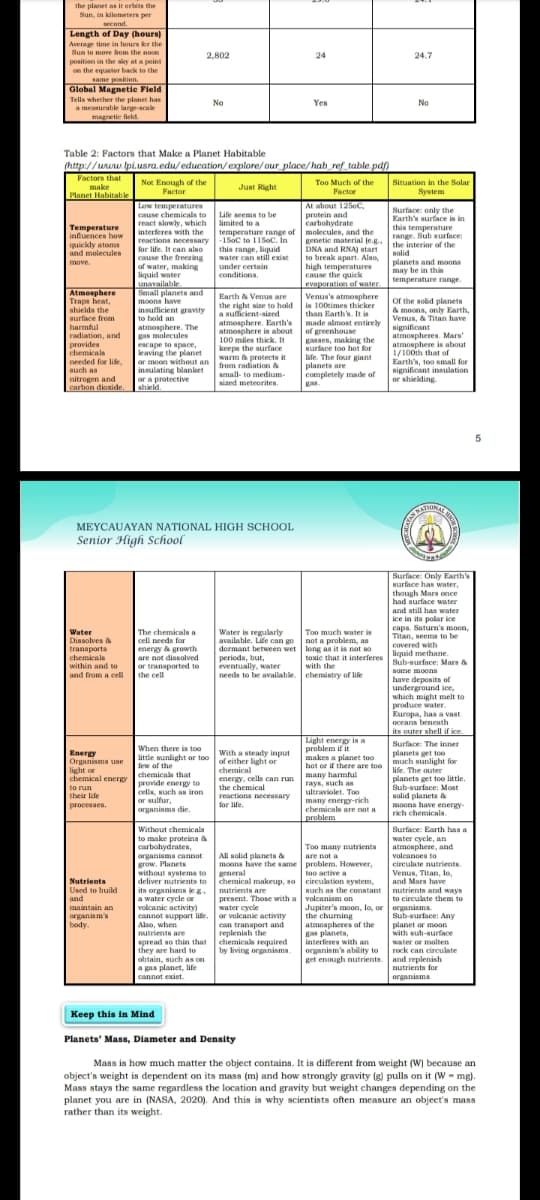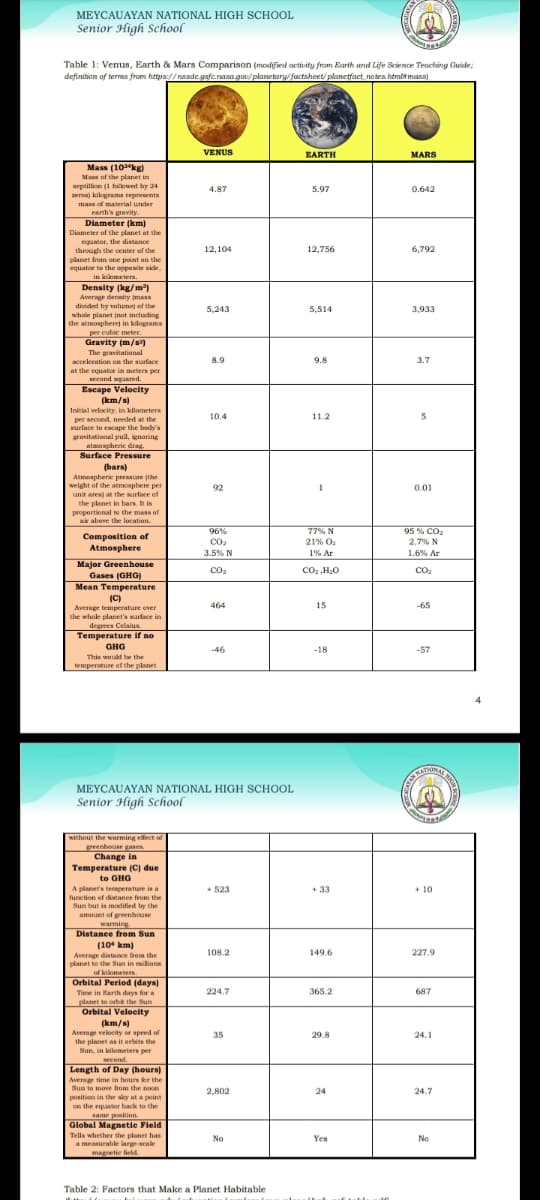Activity #1. Compare and Contrast. Similarities and differences of Venus, Earth and Mars. Do this on a separate sheet of paper. 1. Compare and contrast the three (3) terrestrial planets using table 1. 2. Provide explanations for your observations using table 2. 3. Answer the following guide questions. Guide questions: 1. Does planet size affect gravity? 2. Why do you think Venus has the
Activity #1. Compare and Contrast. Similarities and differences of Venus, Earth and Mars. Do this on a separate sheet of paper. 1. Compare and contrast the three (3) terrestrial planets using table 1. 2. Provide explanations for your observations using table 2. 3. Answer the following guide questions. Guide questions: 1. Does planet size affect gravity? 2. Why do you think Venus has the
Chapter17: Astrobiology: Life On Other Worlds
Section: Chapter Questions
Problem 6P
Related questions
Question
Activity #1. Compare and Contrast. Similarities and differences of Venus, Earth and Mars.
Do this on a separate sheet of paper.
1. Compare and contrast the three (3) terrestrial planets using table 1.
2. Provide explanations for your observations using table 2.
3. Answer the following guide questions.
Guide questions:
1. Does planet size affect gravity?
2. Why do you think Venus has the highest mean temperature among the three planets?
3. Is presence of water a primary factor for a planet to sustain life? Why or why not?
4. Based on your observations using table 2, what are the notable features that makes the
earth the only habitable planet among the three terrestrial planets?
5. What conclusions can you make?

Transcribed Image Text:reactions necessary-1SoC to 11d *
the planet as it erbits the
Sun, in kilometers per
second.
Length of Day (hours)
Average time in hours ker the
Sun to move from the noon
position in the sky at a point
on the equator back to the
same position.
Global Magnetie Fleld
Tells whether the planet has
a measurable large-acale
magretic field
2,802
24
24.7
No
Yes
No
Table 2: Factors that Make a Planet Habitable
(http://www.lpi.usra.edu/ education/explore/our_place/hab_ref_table.pdf)
Factors that
make
Planet Habitable
Not Enough of the
Factor
Too Much of the
Factor
Situation in the Solar
System
Just Right
At about 125oC,
protein and
carbohydrate
Low temperatures
cause chemicals to
react slowly, which
interferes with the
reactions necessary
for life. It can also
cause the freezing
of water, making
liquid water
Surface: only the
Life seems to be
limited to a
Earth's surface is in
this temperature
range. Sub surface:
Temperature
temperature range of molecules, and the
-1Soc to 115oc. In
influences how
quickly atoms
and molecules
genetic material jeg the interior of the
DNA and RNA) start
to break apart. Alao,
high temperatures
cause the quick
evaparation of water.
Venus's atmosphere
is 100times thicker
this range, liquid
water can still exist
under certain
conditions.
solid
planets and moons
may be in this
temperature range.
move.
unavailable
e.
Atmosphere
Traps heat,
shields the
вurface from
barmful
radiation, and
provides
chemicals
needed for lis
such as
nitrogen and
carbon dioxide.
Small planets and
moons have
Earth & Venus are
the right size to hold
a sufficient-sized than Earth's. It is
atmosphere. Earth's
atmosphere in about
100 miles thick. It
keepe the surface
an warm & protects it
Of the solid planets
& moons, only Earth,
Venus, & Titan have
significant
atmospheres. Mars
atmosphere is about
1/100ih that of
Earth's, too small for
significant insulation
or shiekding.
insufficient gravity
to hold an
atmosphere. The
gas molecules
escape to space,
eaving the planet
or moon without an from radiation &
insulating blanket
or a protective
shield.
made almost entirely
of greenhouse
gasses, making the
surface too hot for
life. The four giant
planets are
completely made of
gas.
small- to medium-
sized meteorites.
CATIONAL
MEYCAUAYAN NATIONAL HIGH SCHOOL
Senior High School
Surface: Only Earth's
surface has water,
though Mars once
had surface water
and still has water
ice in its polar ice
caps. Saturn's moon,
Titan, seems to be
covered with
liquid methane.
The chemicals a
cell needs for
energy & growth
are not dissolved
or transported to
Water
Dinsolves &
Too much water is
Water is regularly
available. Life can go not a problem, an
dormant between wet long as it is not so
periods, but,
eventually, water
needs to be available. chemistry of life
transports
chemicals
toxie that it interferes Sub-surface: Mars &
within and to
with the
some moons
and from a cell the cell
bave deposits of
underground ice,
which might melt to
produce water.
Europa, has a vast
ocrans beneath
its outer shell if ice.
Light energy is a
problem if it
makes a planet too
hot or if there are too
many harmful
rays, such as
Surface: The inner
planets get too
much sunlight for
life. The outer
planets get too little.
Sub-surface: Most
salid planets a
moons have energy-
rich chemicals.
When there is too
little sunlight or too
Sew of the
Energy
Organisma use
light or
chemical energy
to run
their life
With a steady input
of either light or
chemical
energy, cells can run
the chemical
reactions necessary
for life.
chemicala that
provide energy to
cells, such as iron
or sulfur,
organisms die.
ultraviolet. Too
many energy-rich
chemicals are not a
processes.
problem
Without chemicala
to make proteina a
carbohydrates,
arganisma cannot
grow. Planets
without systems to
deliver nutrients to chemical makeup, so circulation system,
its organisms le.. nutrients are such as the constant
Surface: Earth has a
water cycle, an
atmosphere, and
valcanoes to
circulate nutrients.
Too many nutrienta
All solid planets &
moons have the same problem. Howerver,
general
are not a
too active a
o.
Venus, Titan, lo,
and Mars have
Nutrients
Used to build
and
i
a water cycle or
volcanic activity)
cannot support life.
Also, when
nutrients are
spread so thin that chemicals required
they are hard to
obtain, such as on
a gas planet, life
cannot exist.
nutrients and ways
to circulate them to
present. Those with a volcanism on
water cycle
or volcanie activity
can transport and
replenish the
Jupiter's moon, lo, or organisma.
Sub-surface: Any
planet or moon
with sub-surface
water or molten
rock can circulate
get enough nutrients. and replenish
nutrients for
maintain an
the chuming
atmoapheres of the
gas planets,
interferes with an
organism's ability to
organis m's
body.
by living organisms.
organisma
Keep this in Mind
Planets' Mass, Diameter and Density
Mass is how much matter the object contains. It is different from weight (W) because an
object's weight is dependent on its mass (m) and how strongly gravity (g) pulls on it (W - mg).
Mass stays the same regardless the location and gravity but weight changes depending on the
planet you are in (NASA, 2020). And this is why scientists often measure an object's mass
rather than its weight.

Transcribed Image Text:Mans of th
MEYCAUAYAN NATIONAL HIGH SCHOOL
Senior High School
Table 1: Venus, Earth & Mars Comparison (modified activity from Earth and Life Science Teaching Guide;
definition of tems from https://nssde.gsfc.nasa.gou/planetaru/ factsheet/planetfact_notes.htmit mass)
VENUS
EARTH
MARS
Mass (10kg)
Mass of the planet in
septillion (1 followed by 24
eros kilegrams represents
4.87
5.97
0.642
mass of material under
earth's gravity.
Diameter (km)
Diameter of the planet at the
equator, the distance
through the center of the
planet from one point on the
equator to the opposite side,
12,104
12,756
6,792
in kilometers.
Density (kg/m)
Avernge density mass
divided by volumej of the
whole planet (not including
the atmospherej in kilograms
5,243
5,514
3,933
per cubic meter,
Gravity (m/s)
The gravitational
acceleration on the surface
8.9
9.8
3.7
at the equator in meters per
second squared.
Escape Velocity
(km/s)
Initial velocity, in kilometers
per second, needed at the
surface to escape the body's
gravitational pull, ignoring
atmospherie drag.
Surface Pressure
10.4
11.2
5
(bars)
Atmospheric pressure (the
weight of the atmosphere per
92
0.01
unit area) at the surface of
the planet in bars. It is
proportional to the mass of
ar above the location.
77% N
95 % CO
2.7% N
96%
Composition of
Atmosphere
Co.
21% O
3.5% N
1% Ar
1.6% Ar
Major Greenhouse
Gases (GHG)
Mean Temperature
(C)
Average temperature ever
the whole planet's surface in
CO2
Co, H,0
со.
Co2
464
15
-65
degrees Celaiua.
Temperature if no
GHG
-46
-18
-57
This would be the
temperature of the planet
4
ATONAL
MEYCAUAYAN NATIONAL HIGH SCHOOL
Senior High School
without the warming efect of
greenhouse gases.
Change in
Temperature (C) due
to GHG
A planet's temperature is a
+ 523
+ 33
+ 10
function ef distance from the
Sun but is modified by the
amount of greenhouse
warming.
Distance from Sun
(104 km)
Average distance from the
planet to the Sun in milions
108.2
149.6
227.9
of kilometers.
Orbital Period (days)
224.7
365.2
687
Time in Earth days for a
planet to orbi the Sun
Orbital Velocity
(km/s)
Avernge velocity or speed of
the planet as it erbite the
Sun, in kilometers per
35
29.8
24.1
second.
Length of Day (hours)
Average time in hours er the
Sun to move from the noon
position in the sky at a peint
on the equator back to the
same position.
Global Magnetic Field
2,802
24
24.7
Tells whether the planet has
a measurable large scole
No
Yes
No
magnetie field
Table 2: Factors that Make a Planet Habitable
Expert Solution
This question has been solved!
Explore an expertly crafted, step-by-step solution for a thorough understanding of key concepts.
This is a popular solution!
Trending now
This is a popular solution!
Step by step
Solved in 3 steps with 2 images

Recommended textbooks for you


Foundations of Astronomy (MindTap Course List)
Physics
ISBN:
9781337399920
Author:
Michael A. Seeds, Dana Backman
Publisher:
Cengage Learning

Stars and Galaxies (MindTap Course List)
Physics
ISBN:
9781337399944
Author:
Michael A. Seeds
Publisher:
Cengage Learning


Foundations of Astronomy (MindTap Course List)
Physics
ISBN:
9781337399920
Author:
Michael A. Seeds, Dana Backman
Publisher:
Cengage Learning

Stars and Galaxies (MindTap Course List)
Physics
ISBN:
9781337399944
Author:
Michael A. Seeds
Publisher:
Cengage Learning


Astronomy
Physics
ISBN:
9781938168284
Author:
Andrew Fraknoi; David Morrison; Sidney C. Wolff
Publisher:
OpenStax

Horizons: Exploring the Universe (MindTap Course …
Physics
ISBN:
9781305960961
Author:
Michael A. Seeds, Dana Backman
Publisher:
Cengage Learning